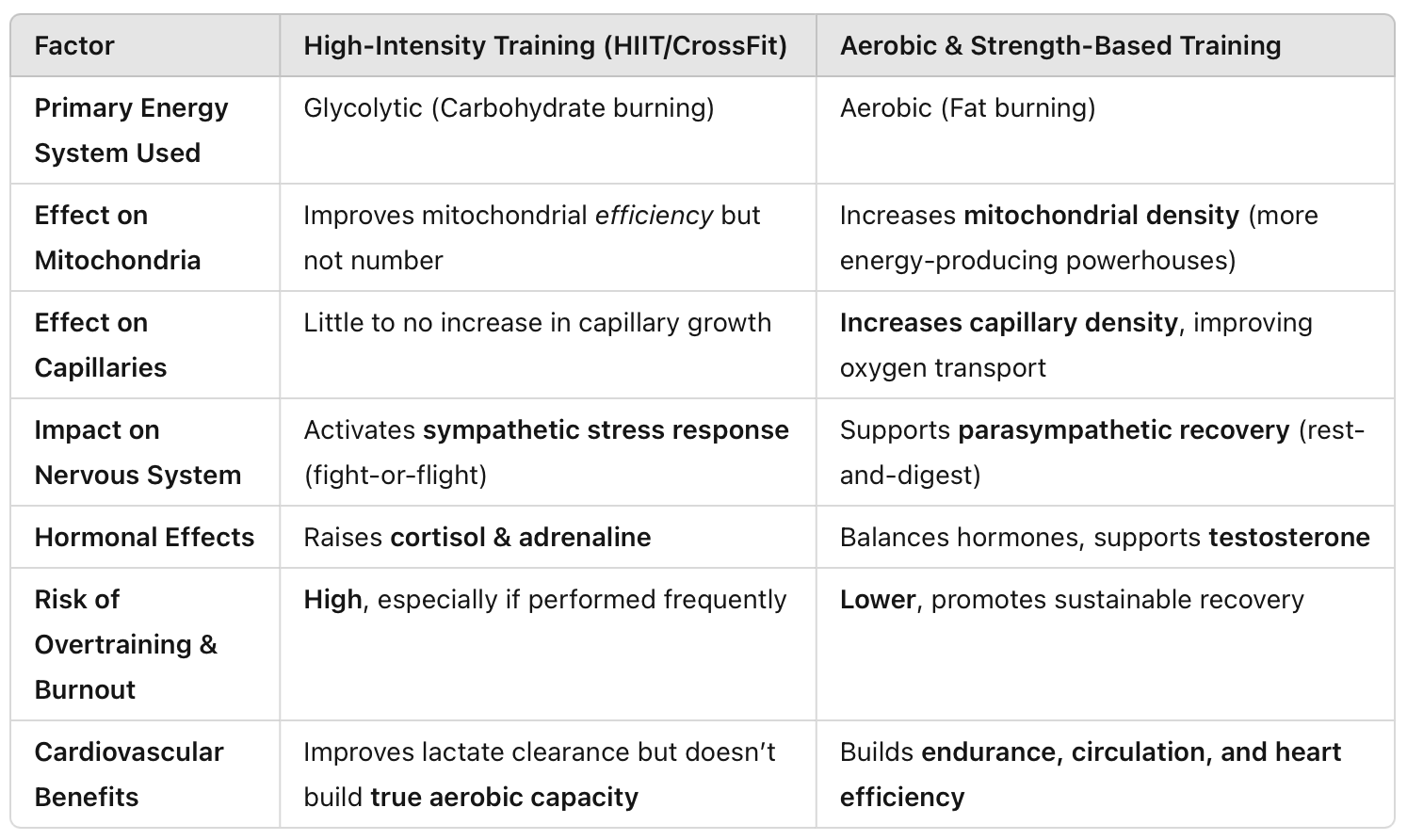Is High-Intensity Exercise Good for the Heart?
For decades, we’ve been conditioned to believe that the harder we train, the fitter and healthier we become. CrossFit-style workouts, HIIT classes, and boot camps promise peak conditioning through intense effort, sweat, and exhaustion. But when it comes to true cardiovascular health, does high-intensity training actually improve heart function—or could it be working against you?
The Truth About High-Intensity Training and Heart Health
The idea that intense exercise automatically leads to a stronger heart is misleading. While glycolytic workouts (high-intensity, carbohydrate-burning training) can improve mental resilience and buffering capacity (your ability to tolerate and clear lactate), they do very little to improve aerobic fitness at the cellular level.
Here’s why:
🚫 Glycolytic exercise relies on carbohydrate metabolism, meaning it doesn’t encourage your body to build the foundational aerobic infrastructure needed for long-term heart health.
🚫 You become better at surviving intense efforts, but that doesn’t mean your mitochondria, capillary networks, and muscle fibers are improving in a way that enhances endurance or metabolic health.
🚫 Over-reliance on high-intensity training without an aerobic base can lead to increased stress hormone production, poor recovery, and over time, an inefficient cardiovascular system.
🚫 Overtraining risk skyrockets with repeated glycolytic training, leading to chronically elevated cortisol, suppressed testosterone, poor sleep, and nervous system burnout.
If you’re suffering from Aerobic Deficiency Syndrome—a state where your body struggles to efficiently use fat for fuel—jumping into high-intensity workouts can be counterproductive or even harmful to heart health.
High-Intensity Training vs. Aerobic & Strength Training: The Real Differences
The Problem with the “Sweat & Score” Mentality
Most modern fitness programs prioritize intensity over progress in actual health markers. People chase faster times, heavier weights, and exhaustion, believing that more sweat = better results.
But the true measure of fitness isn’t how much you suffer in a workout—it’s how well your body adapts, recovers, and sustains energy. If your training leaves you constantly exhausted, stressed, and carb-dependent, it’s time to rethink your approach.
The Smarter Way to Train for Heart Health
Instead of burning yourself out with glycolytic workouts, focus on the two key pillars of heart-focused fitness:
1. Zone 1 & Zone 2 Aerobic Exercise
Purpose: Builds mitochondria, increases capillary density, and improves fat oxidation.
Example: Walking, cycling, rowing, or running at a pace where you can hold a conversation (55-75% of max heart rate).
2. Heavy, Low-Rep Strength Training
Purpose: Strengthens the heart without unnecessary metabolic stress, improves nervous system efficiency, and builds functional muscle.
Example: Compound lifts (squats, deadlifts, presses) with low reps (3-6 per set) and longer rest periods.
Why This Approach Works Best for Men Over 50
Men in their 50s who focus on heart-healthy exercise should aim for more fat metabolism, not just carbohydrate metabolism. That means:
✔ Prioritizing aerobic efficiency (more mitochondria & capillaries) over glycolytic stress.
✔ Reducing unnecessary cortisol spikes to support testosterone and recovery.
✔ Avoiding excessive fatigue and overtraining, which compromise heart health over time.
Want to Learn How to Train Smarter for Heart Health?
If you’re ready to break free from the high-intensity trap and start training for real cardiovascular health, join me for my upcoming Men’s Health Webinar.
In this exclusive session, I’ll reveal:
✅ The truth about exercise intensity and heart health
✅ How to train in a way that builds longevity, not just pain tolerance
✅ Why the right mix of aerobic training and strength work is the key to lasting vitality
✅ A blueprint for optimizing your metabolism, endurance, and performance—without burnout
[Register Here] – Take control of your heart health today!
